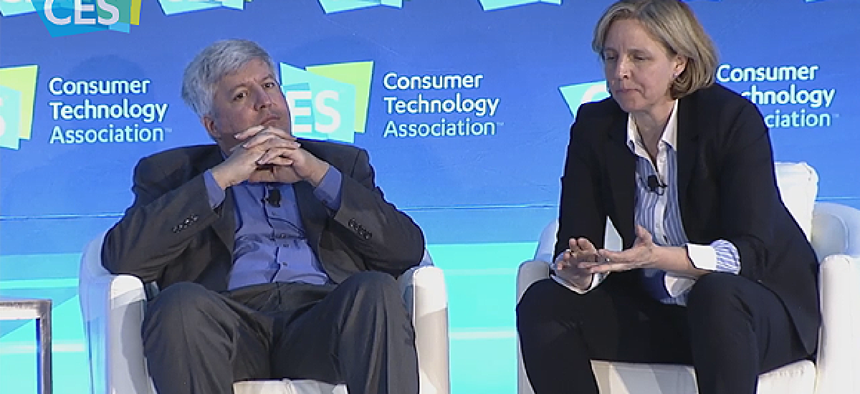5 strategies for an innovation nation


Connecting state and local government leaders
Speaking at CES in Las Vegas, CTO Megan Smith outlined the administration’s initiatives for an innovation ecosystem that encourages public, private and academic participation.
Building an innovation nation will require an “all hands on deck approach,” calling all levels of government, private sector companies, philanthropists, non-profits and the larger tech community, to make it happen. That’s according to U.S. CTO Megan Smith and Office of Science and Technology Policy Deputy Director for Technology and Innovation Tom Kalil, who spoke at the Consumer Electronics Show in Las Vegas.
Kalil and Smith discussed five key initiatives that are driving innovation in cities across America: the Maker Movement, smart cities, TechHire, workforce diversity and the “tour of duty” hiring model that’s helping bring top tech talent to government.
Maker movement
The first White House Maker Fair in 2014 was a way to bring together those companies, foundations, schools and non-profits providing the resources and technology for makers and entrepreneurs to develop innovative tools and systems and to continue advancing manufacturing technologies within the United States.
“In same way we went from the mainframe to the minicomputer to the PC to the computer that fits in your pocket, “Kalil said, “we’ve also been democratizing access to the tools that are necessary to design and make just about anything.”
As an example of that democratization, AutoDesk, a Maker Fair participant and CES panelist, recently began offering its suite of professional tools for 3D design, mechanical engineering and entertainment software for free to any student, teacher, school and small smartups.
Smart cities
The administration has launched a $160 million research initiative for building smart cities that includes the MetroLab Network, a coalition of universities and cities also focusing and working towards smart city programs in 27 cities.
As part of its work with the MetroLab Network, Seattle and its partner the University of Washington installed rain gauge sensors across the city to track severe weather events and downpours. This enables the city to predict where the heaviest rainfalls and flooding will occur by neighborhood so it can alert the public and deploy the necessary resources before it rains.
Additionally, the city is installing sensors in 45 percent of its buildings to monitor electricity and water use. By applying Microsoft Azure’s machine learning tools to its energy data, Seattle has reduced its carbon output by 20 percent, according to Michael Mattmiller, the city’s CTO and a CES panelist.
In terms of community engagement, the city’s Hack the Commute event last year to found ways to solve transportation challenges. With six other regional governments, Seattle was able to provide 150 new transportation datasets to the community that yielded 14 prototype applications to address the city’s transportation challenges.
TechHire
The White House’s TechHire initiative addresses the more than half-a-million job openings in the tech field with an “ecosystem” approach, working with employers in need of tech talent, municipal leadership and regional innovation teams to harness conventional and nontraditional approaches to hire and train technology workers. The goal is to “break across and get into all of our communities and pull them into this incredible movement that we’re part of,” Smith said.
While continuing to hire those with four-year and two-year technology degrees, Smith emphasized the importance of opening boot camps and new training programs that offer additional opportunities to develop tech talent. This requires workforce development teams and partners in state, city and federal agencies to help with workforce matchmaking and to spread the word on regional innovation teams and tech meet-ups. Since its launch in March 2015, TechHire has acquired 35 city partners.
Diversity
The White House continues its ongoing efforts to broaden diversity and expand inclusion within the tech field, especially to women and people of color, focusing “on the culture of the companies and how are we changing advancement and inclusion, how are we adapting in our venture capital,” Smith said. This means opening opportunities to all Americans, being aware of unconscious bias in hiring and ensuring a diverse candidate pool.
Tour of duty
“Tour of duty” hiring is another administration model for digital government recruitment. Programs like the Presidential Innovation Fellows, the U.S. Digital Services and 18F offer opportunities for techies and innovators to rotate into federal tech jobs for a year or two and apply private-sector-type strategies to government programs, services, projects and policies.
All these efforts depend on communities of innovators – from government, the private sector, tech companies, universities and entrepreneurs. “It is an ecosystem plan that’s going to take all of us, and [the government is] just one member of that ecosystem.” Smith said.




